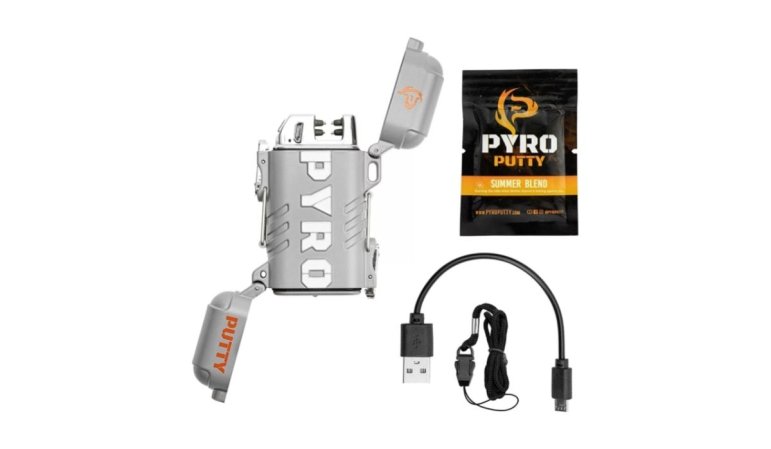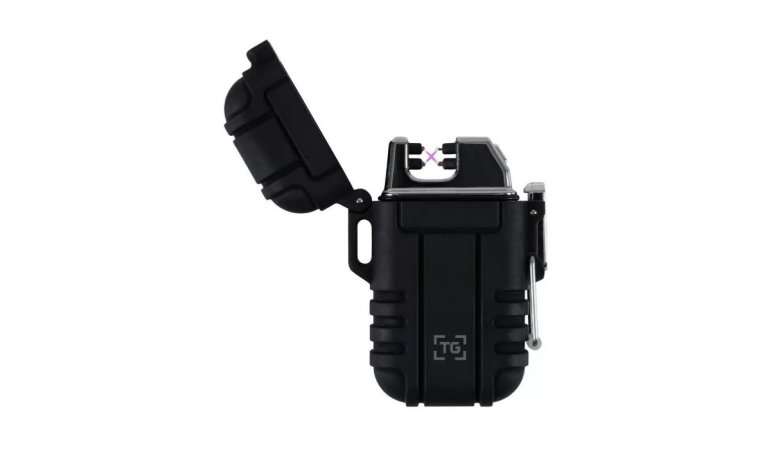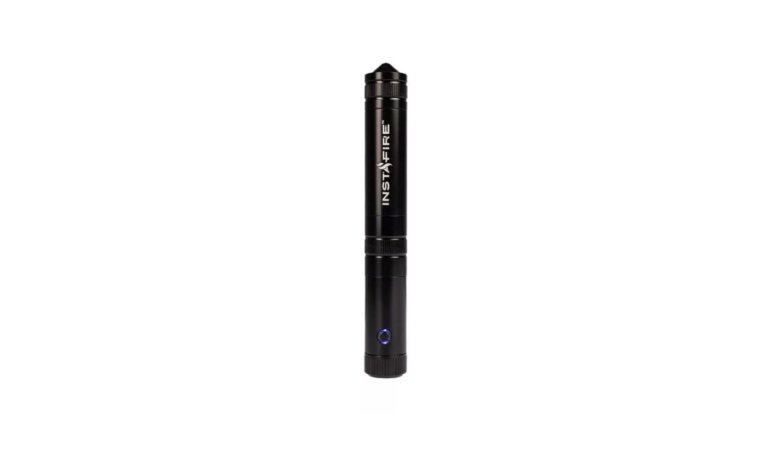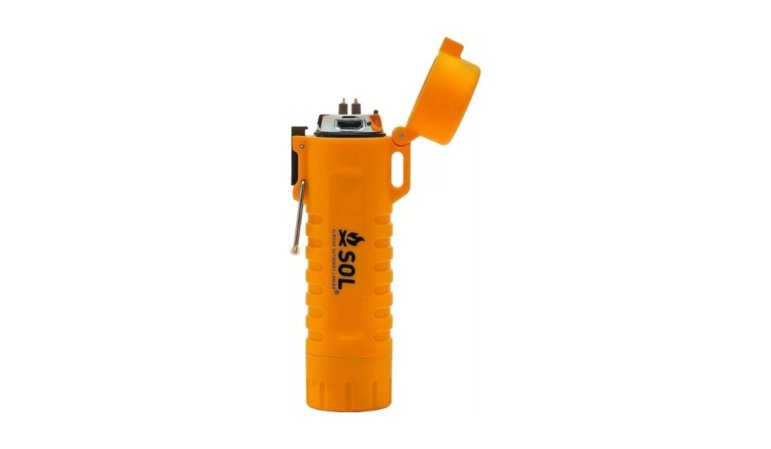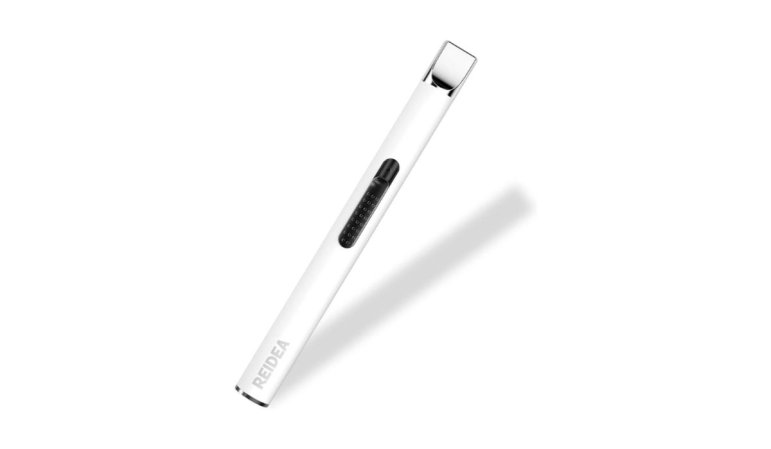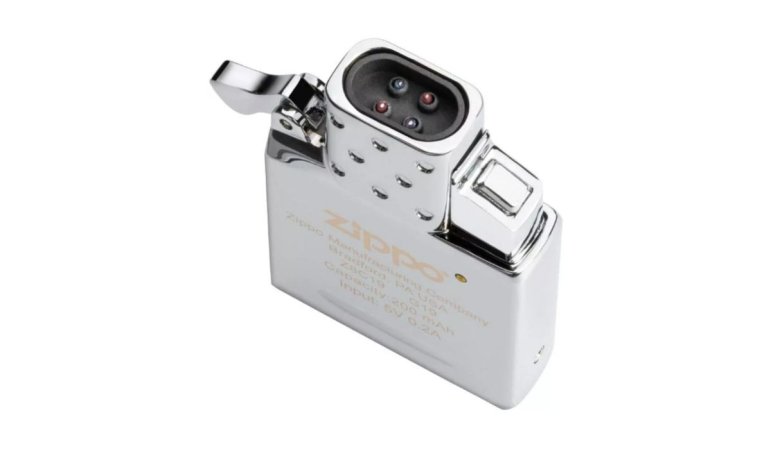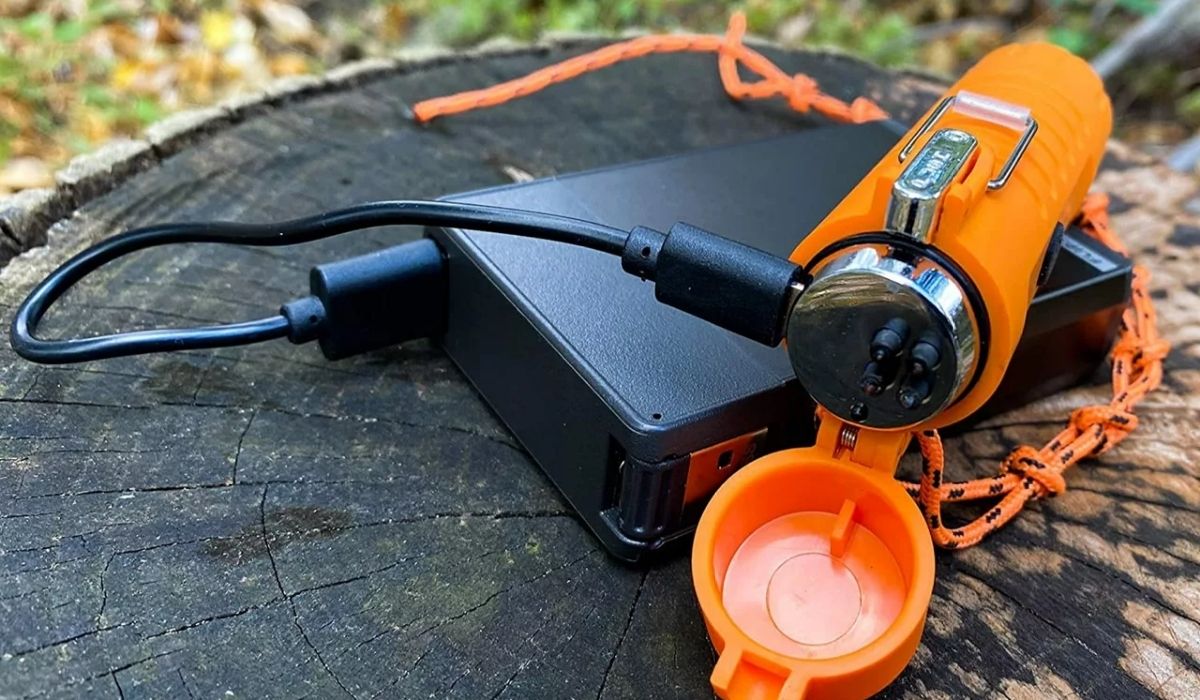

We may earn revenue from the products available on this page and participate in affiliate programs.
Plasma lighters are just the latest in a long line of tools that make fire possible. At first, there were (I imagine) cavemen sitting around a fire they built with a bow drill, remarking at how lazy their neighbor was for waiting for lightning to strike and create fire for him. Then came people with flint and steel who just couldn’t be bothered to toil away with a bow drill — and so the progression went.
For a long time, it was hard to imagine anything easier than flicking a lighter open and having instant flame. Getting excessive flame with a little modification was a mandatory skill for any aspiring pyromaniac. The problem is that old-school lighters are a lot less economical than you think. Sure, disposable Bic lighters are only a few bucks, but they don’t last very long and they generate a lot of waste for what you get out of them. Even refillable lighters burn through fuel faster than we’d like.
Enter plasma lighters. These handy devices are a modern twist on old technology; if you’ve ever function-checked a spark plug, you’ve basically seen the concept in action. Plasma lighters are rechargeable, easy to use, and don’t involve any nasty chemicals. They’re rugged enough for the great outdoors and civilized enough to use in your home. They’re also very entertaining, so we won’t blame you if you haven’t totally aged out of your inner pyro just yet.
Best Overall
Pyro Putty Elite Rechargeable Dual Arc Lighter
Pros
- Rugged, go-anywhere housing is ready for anything
- Dual-arc design is quick to light
- Storage container keeps tinder handy
- Includes a ball of Pyro Putty tinder
Cons
- Replacing the tinder with name-brand Pyro Putty isn’t cheap
- Aggressive styling isn’t for everyone
- Tinder must be placed between the charged poles to light
Product Specs
- Claimed lights per charge: Up to 300
- Arc: Dual
Best Value
TG Plasma Lighter
Pros
- More affordable to buy and charge than a traditional lighter
- Ignition is waterproof and windproof
- Fully charge the battery in two hours
- Cheap enough to buy one for everyone in your group
Cons
- Design is shared by other vendors
- Requires small tinder that can fit between the poles
- Not quite as sturdy as some of our other picks
Product Specs
- Claimed lights per charge: 300
- Arc: Dual
Editor’s Choice
Instafire Crossfire
Pros
- Ready for escape with a built-in glass-breaker
- End compartment stores your preferred tinder
- Battery promises more lights than most of the competition
- Thin design is easy to slip in a pocket or pouch
Cons
- By far the most expensive lighter here
- How practical is the glass-breaker, really?
- Might be tricky to use with gloves
Product Specs
- Claimed lights per charge: 500
- Arc: Dual
Best Survival Zippo Lighter
SOL Fire Lite
Pros
- Built-in flashlight offers high, low, and strobe settings
- Lanyard can be used as tinder or a wick
- Dual arc is strong enough to light stubborn materials
- Exposed arcs tackle larger tinder with ease
Cons
- A little bulky for everyday use
- No place to store dry tinder
- Orange housing is great for survival kits but not tactical
Product Specs
- Claimed lights per charge: 300
- Arc: Dual
Best Plasma Lighter for Indoors
Reidea Candle Lighter
Pros
- Long, slim shape is great for reaching deeper candle wicks
- Safety lock prevents accidental lighting
- Exposed arc lights hard-to-reach wicks
- Great for lighting a grill or fire pit
Cons
- Single arc isn’t as efficient as a dual arc
- Not as sturdy as our other picks
- Number of lights per charge isn’t available
Product Specs
- Claimed lights per charge: not available
- Arc: Single
Best Zippo Refill Plasma Lighter
Zippo Lighter Insert
Pros
- Legendary Zippo quality without the lighter fluid
- Dual-arc design is effective and strong
- Fits all classic Zippo lighters
- Charges completely in one hour
Cons
- Requires a separate Zippo housing
- Needs to be removed for charging
- One of the more expensive plasma lighters out there
Product Specs
- Claimed lights per charge: approximately 300
- Arc: Dual
Why you should trust us
The whole premise behind plasma lighters is creating fire from electricity rather than combustible fuel. If you can recharge your lighter from the sun, you don’t have to rely on a store or delivery person to keep your lighter operational. That makes plasma lighters an excellent survival and camping tool. We dedicate a lot of effort to researching the best tactical, survival, and outdoor adventure gear and we know a winner when we see it. Some of our favorite pieces of gear are the water filters, camp stoves, and hatchets that make us self-sufficient in the wild. A plasma lighter fits right in. Hell, it might even save some space in your pack.
Types of plasma lighters
Aside from shape and size, plasma lighters are essentially all very similar. They all use a battery to generate intense, controlled heat. Some are built to withstand the elements and others are better suited to a candlelight dinner, but the components are largely the same. The main difference that affects performance is the number of arcs used to generate enough heat to spark a flame.
Single-arc plasma lighters
At a minimum, a plasma lighter must have two points separated by a small enough gap that an electrical charge can cross the gap, but far enough apart that whatever you’re trying to light can fit between them. These two points create a single band of heat, called an arc. Arcs appear as purple light and are very hot.
This method generates quite a bit of heat, but applications can be limited. Candle wicks and small pieces of tinder are no problem, but the kind of damp material you might encounter at a campsite might present too much of a challenge for a single arc. Size can also be an issue. Lighting a cigarette with a single arc is easy enough, but cigars and pipes might require something larger.
Dual-arc plasma lighters
For a little bit more money, you can get a plasma lighter with two arcs instead of one. This configuration creates an X-shaped arc pattern that results in more heat than a single-arc plasma lighter would produce. Some combined arcs also produce enough to insert into the bowl of a pipe, which can be difficult with most single-arc plasma lighters.
This is what we recommend for most outdoor activities. Having two arcs instead of one gives you more power to work with and adds a layer of redundancy that’s valuable when you’re far removed from civilization. All our picks for camping and survival settings use two arcs.
Key features of plasma lighters
Plasma lighters are surprisingly simple devices. They use a compact, rechargeable battery to generate heat with one or more pairs of points that are not unlike a spark plug. With no removable components, housings are typically waterproof and sturdy. Value-adding features vary from product to product and may include glass-breakers, storage compartments for tinder, and flashlights.
Compact size
Plasma lighters tend to be the same size as their traditional predecessors. That makes them easy to stash in a pocket, center console, or hip belt of your pack for easy access. If you charge yours off a solar power bank, which is what we recommend, the extra space requirement will be similar to what you’d need for a bottle of extra lighter fluid. Size-wise, it’s a wash; but the solar bank can theoretically charge your plasma lighter indefinitely and lighter fluid will eventually burn out.
Compared to other bushcraft favorites, plasma lighters are far more compact. Sure, a short ferro rod itself is smaller, but you’ll probably use a knife as a striker and that approach is really only appropriate for camping. Good luck lighting up at the cigar bar like that. The oldest alternative is the prehistoric bow drill. That one will get you serious bushcraft points, but it’s not very practical except as a last resort.
Rechargeable battery
Rechargeable batteries are the secret sauce that makes plasma lighters so great. Instead of carefully pouring lighter fluid into a tiny reservoir, you can just plug your lighter into a power bank or outlet with a small USB cord and be topped off in no time.
This is a huge asset in off-grid situations like you’d experience when camping or responding to some kind of emergency. Instead of counting down the days until you run out of fuel in the wilderness, you can just hang a solar charger off your pack, keep moving, and plug in your plasma lighter every 300 or so lights.
Benefits of plasma lighters
In the same way that a Zippo or Bic lighter offers advantages over older fire-starting methods like bow drills and ferro rods, plasma lighters represent a natural progression of making it easier and faster to start a fire. It doesn’t matter if you’re just trying to light candles around the house or survive in the wilderness; a plasma lighter might be your best bet for success.
Clean, sustainable power
The obvious advantage to owning a plasma lighter is freeing yourself from refilling your lighter with fluid to keep it operational. Quality lighter fluid like the kind sold by Zippo costs about $9 for a 12-ounce bottle (and that’s what we recommend if you choose to use a traditional, refillable lighter). That adds up quickly, and refilling the tiny reservoir in your lighter can be a tedious, messy job.
Plasma lighters run on electricity, so topping it off is as easy as plugging in a USB cable. The cost per charge is so small we doubt you could even measure it, and that will get you about 300 lights from most plasma lighters. Keep in mind that even a handheld solar charger can keep a plasma lighter up and running, which means you can have access to instant fire totally off-grid.
Built for adventure
Being rechargeable and free of combustible fuel makes plasma lighters a great option for outdoor adventure — so does the fact that they tend to be very durable and resilient. With the exception of our pick for indoor use, the plasma lighters on this list are built to be waterproof and take an impact without missing a beat. That’s nice peace of mind compared to flicking a traditional lighter in vain after it’s gotten wet.
Another weak point of traditional lighters is their performance in the wind. Even without rain, wind can blow out the flame and leave you in the cold. That’s annoying if you’re lighting up a smoke, and downright dangerous if you’re trying to light a campfire for survival. Plasma lighters are unaffected by wind because they create heat with electricity, much like a spark plug.
Ease of use
When it comes down to it, plasma lighters are just more convenient than the alternatives. They work in the rain, they work in the wind, and they can be powered by the sun. Unlike a traditional lighter, they can be used upside down without burning your hand. With no reservoir to refill, you’ll never have to risk spilling expensive lighter fuel all over the place.
Plasma lighters are probably the best option for most people. Unlike bushcraft fire-starting methods, there’s no learning curve whatsoever. Unlike traditional lighters, there’s no (measurable) recurring cost of ownership or maintenance required. Because they’re so rugged, plasma lighters are also just as useful for experienced campers. The future is now, and it is bright.
Plasma lighter pricing
Most of the plasma lighters you’ll find cost less than $20. These can be a great value because they’re simple, effective, and can be refueled for practically nothing. There are only a few designs at this price that are branded by multiple vendors. Some use a single arc, while others use dual arcs. Cartridges for refillable Zippos also fall into this price range, but you’ll need to buy a compatible lighter housing, as well. Plasma lighters in this price range are great additions to your roadside emergency or survival kit.
More advanced plasma lighters can cost as much as $60. These use proprietary designs and include features designed for specific tasks. This is the price range where you’ll find perks like glass-breakers, flashlights, and storage areas for tinder. If you plan on getting a lot of use out of your plasma lighter in austere environments, this is the way to go. We recommend including one of these in your go bag or camping pack.
How we chose our top picks
There are a lot of plasma lighters on the market, but many of them are the same product repackaged and sold by multiple vendors. That’s why our pick for best value, the TG plasma lighter, looks so familiar to other options on the market. It works well and doesn’t cost much, which is all you need in most situations. Our other picks are more specialized and come with features that help them stand out from the crowd. We sought out high-quality plasma lighters to get the job done in camping, survival, and everyday situations. The ones that made the list vary in design and function, so you can find exactly what you need.
FAQs on plasma lighters
You’ve got questions, Task & Purpose has answers.
Q: How do plasma lighters work?
A: When activated, plasma lighters charge opposing poles to create an intense exchange of electricity that creates a large amount of heat along a concentrated path. Place flammable material into the purple arc or arcs to light it.
Q: Are plasma lighters better than traditional lighters?
A: Plasma lighters are better than traditional lighters in certain ways. Plugging in a USB cable is cleaner than pouring lighter fluid. Being able to recharge your lighter indefinitely with a small solar panel can be more practical than packing extra lighter fluid. Plasma lighters also perform better in bad weather.
Q: How long does a plasma lighter last on one charge?
A: Most of the plasma lighters we’ve seen are advertised as being able to provide 300 lights on one charge. Your experience may vary depending on external factors, but that’s a good benchmark.
